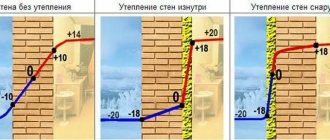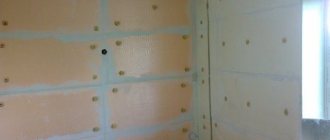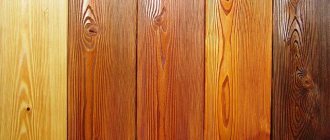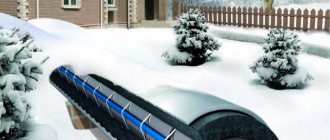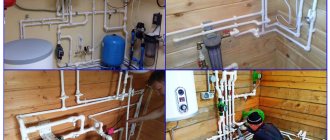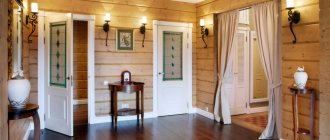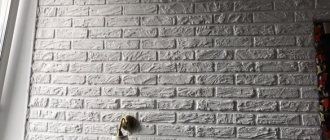Waterproofing walls is a mandatory procedure when constructing a building. Unprotected surfaces will be exposed to moisture - precipitation, condensation - and deteriorate, and mold may appear on them. When carrying out work, it is necessary to strictly adhere to the technology; this is the only way to ensure protection of brick, wooden or concrete surfaces from water, extending the service life of the house.
Application of liquid waterproofing
Sources of moisture
Condensation forms on the internal surfaces of the walls in the room. This occurs due to increased air humidity. In bathrooms, kitchens, basements, non-residential buildings (garage, shed, workshop), especially if they do not have a heating system, air humidity is constantly increased, so protecting the walls from the inside is mandatory.
Another reason for the appearance of condensation is insufficient quality insulation of the house.
External surfaces come into contact with precipitation and groundwater.
Typical mistakes when installing waterproofing in an apartment
Waterproofing is laid only on the floor
– moisture protection also needs to be installed on the walls to a height of 10 cm around the entire perimeter of the room. It is especially important to comply with these standards in the bathroom, where the moisture-soaked floor creates ideal conditions for mold fungi.
Kitchen without waterproofing
– The faucet, pipes or dishwasher may leak. The concrete is destroyed and moisture seeps into the neighbors below.
Waterproofing on uneven floors
– material laid on an uneven dusty surface with cracks or chips will “lag behind”, lose its characteristics and allow moisture to pass through.
It happens that there is no waterproofing at all, including in apartments, because the builders decided to save on materials.
Why is waterproofing needed?
The absence of a waterproof coating will significantly reduce the service life of the building; the material (concrete, brick, wood) will deteriorate, cracks, mold, and moss will appear on it. To prevent this from happening, you need to waterproof the walls outside and inside.
In addition, protecting internal surfaces will help:
- prevent the appearance of damp smell;
- maintain an optimal indoor microclimate;
- protect pipes and other metal structures from corrosion;
- delay the need for cosmetic and major repairs.
Garage moisture protection
The garage is home to the car, which means it must also maintain an appropriate microclimate in which your four-wheeled friend will feel good.
Most of the machine parts are made of metal, so exposure to moisture is extremely contraindicated. This will lead to the appearance of rust, which may result in deterioration, that is, unnecessary expenses for repairs and replacement of spare parts. Even the most car enthusiast is not entirely comfortable staying in a room with high humidity for a long time, so there is no escape from waterproofing.
What materials can you recommend? The list can be called decent, but it’s up to you to choose:
- Tape and roll materials. The most common of this group is considered to be roofing felt.
- Coating or liquid sealants. These compositions are prepared on the basis of a bitumen or rubber base.
- Concrete mixtures.
The entire process of waterproofing a garage comes down to the following procedures:
- Foundation waterproofing.
- Roofs.
- Wall insulation.
If you don’t have a cellar in your garage, then you can get by with a minimum of funds.
- During the construction of a garage, roofing felt is placed on the foundation.
- If the garage has already been built, then the foundation can simply be coated with mastic or plastered.
If a basement is provided in this room, then this process must be approached more seriously, almost the same as in a free-standing basement.
To insulate the roof, you need to choose a material based on its type:
Internal waterproofing
- If the surface is flat, then it is best to use roofing felt, warming up the joints well, and then fill the entire surface with resin.
- A roof with slopes must be covered with waterproofing material before laying the coating. To do this, they buy a special film and nail it directly to the rafters, and then the coating is laid on top.
- If you wish, you can use slabs. The seams between them must be sealed with sealants.
Waterproofing garage walls from the inside is extremely rare. But for greater reliability and maximum protection from moisture, this process is still better done.
- You can cover the walls with concrete mixtures. They are purchased ready-made and diluted with water according to the instructions. For better adhesion, it is advisable to moisten the wall surface with water before application.
- The second option is to use vapor and waterproofing film. Before using it, all cracks and crevices must be sealed.
After completing all the recommended procedures, you yourself will notice how the microclimate in the garage will change.
Types of waterproofing materials
According to their purpose, materials are divided into 4 types:
- sealing;
- anti-corrosion;
- hydro- and heat-insulating;
- antifiltration.
In appearance, waterproofing can be liquid or roll.
An example of using rolled waterproofing
Bitumen mastic
Bitumen is an elastic mass that is a product of oil refining. Creates a dense waterproof film on the surface and is not subject to cracking. Fills the smallest cracks, penetrates into the pores of the base. Used in combination with roll material or independently. Designed to protect the wall from the outside and treat the foundation.
Bitumen mastic is easy to apply; even a person with no experience can cope with the task. The work takes a little time. The material is sold in the form of bars, which must be heated to 150 degrees to melt before use.
The disadvantages include the duration of hardening. If low-quality compounds are used, the resulting coating may crack over time.
Polymer mastic
Polymer mastics are acrylic-based plastic adhesive compositions used for waterproofing walls from the inside or outside. In addition to protection from moisture, it improves the thermal insulation properties of the treated surface.
Advantages of polymer mastic:
- forms a dense, even coating that does not require finishing;
- fireproof;
- protects against moisture, fungus, moss;
- has a safe composition that allows its use in bathrooms and other rooms;
- Available in a wide range of colors;
- resistant to sub-zero temperatures;
- dries quickly;
- elastic, when the base dries or deforms, it retains its integrity.
Colored polymer mastic
Deep penetration compositions
Dry mixtures containing quartz sand, cement and polyurethane resins are diluted with water immediately before use. After drying, they form an airtight film that reliably protects the surface.
The application technology is extremely simple; the work can be performed by a non-specialist. Penetrating compounds are used primarily inside the home.
Roofing felt and roofing felt
Both materials are used to waterproof the outside of the wall and protect the foundation from moisture.
Ruberoid is a rolled material consisting of a base (cardboard, fiberglass) and impregnation (most often bitumen). Roofing felt is a cardboard sheet impregnated with a tar composition. The first is superior to the second in its properties; only it costs less.
Membrane (film)
It is a roll material made of synthetic rubber or PVC. Used indoors and outdoors. A significant drawback is instability to mechanical stress. Waterproofing film for walls can easily be damaged during installation.
Covering the foundation wall with a membrane
Injection waterproofing
This type includes:
- epoxy compounds;
- acrylate gels;
- polyurethane compounds.
Holes are drilled in the wall in increments of 50 cm into which liquid is injected under high pressure. The method is quite expensive and requires special equipment, so its use is justified only in very complex cases when it is impossible to use other materials.
Features of the method
Construction waterproofing mixtures differ in their use and composition. At the same time, they are divided into several types according to the following criteria:
- By type of material: roll (film, roofing felt), powder (construction dry mixes), liquid.
- By chemical composition: polyethylene, cement, bitumen, rubber, acrylic, PVC materials, silicone (silicon).
- By method of implementation: sealing, penetrating, coating, membrane.
As you can see, there are many types of waterproofing, each of which has its own characteristics of operation outside and inside the premises.
Outside buildings
When applying waterproofing, it is very important to take into account the air temperature and the amount of sunlight on the base. The mixtures are used at temperatures from +50C to 350C. Excessive sunlight negatively affects the applied powder or liquid waterproofing, as it causes water from the solution to evaporate very quickly. As a result of the hydration reaction, the composition will not achieve the declared characteristics and will not be able to perform its functions. Therefore, the workplace must be protected from solar radiation.
The main distinctive feature of facade waterproofing materials is the presence of such characteristics as frost resistance. This indicator is measured in freeze and thaw cycles. The material is considered frozen when the negative temperature is below the operating temperature indicated in the labeling.
Indoors
The main indicator for internal use is environmental cleanliness and fire safety.
Therefore, materials made of PVC, bitumen, and rubber are not recommended for interior work. Sometimes they cause allergic reactions. There is also one important feature of using waterproofing in rooms, which our builders forget about. Any powder and liquid compositions perfectly protect against moisture penetration on planes, but do not work well in corners. Therefore, at the junction of vertical and horizontal surfaces treated with insulation, a special membrane tape with an elastic non-penetrating gasket in the middle should be used.
Location of insulation cover
Waterproofing a wall can be done in 2 ways: horizontal and vertical.
Vertical
This method is used both during the construction process and during renovation work. Use roll or liquid waterproofing material or both at the same time.
Horizontal
The rolled material is laid on the base where the wall is being built. Roofing material or film will prevent the absorption of moisture from the cellar, basement or soil.
Horizontal waterproofing
Installation of horizontal waterproofing is possible only at the construction stage.
Cleaning and leveling surfaces
To ensure good adhesion of the waterproofing to the base, the surfaces are thoroughly cleaned, removing dirt, dust and greasy stains. In this case, a sandblasting machine or metal brushes are used. If there are cavities, cavities, potholes, deep cracks and other defects, they are cleaned and sealed.
When preparing plaster waterproofing for insulation of brick walls and concrete surfaces, notches are made with hand or mechanized tools for the same purpose.
To increase the service life and guarantee the quality of waterproofing of all types (excluding plaster insulation with cement-sand mortar), the surfaces are dried before applying it. This operation is performed using electric blowers, air heaters, lamps and infrared radiation units.
A primer must be applied if bitumen and paint compounds are to be applied to the insulated surfaces. It is performed with a solution of bitumen in gasoline in a ratio of 1:3. If possible, it is better to warm up this composition and the surface: the primer will then better fill the pores of the material.
Sometimes heating the base is replaced by applying two layers of primer:
- A cold solution of bitumen in kerosene or diesel fuel.
- A solution of bitumen in gasoline.
Primer for external and internal walls
The primer is applied to the insulated surface using a spray gun, spray gun or brush.
If the water pressure exceeds 1 m of the water column, then external waterproofing is used (on the water pressure side). If the pressure is less, you can install insulation from both the outside and the inside.
Internal protection
Waterproofing of internal walls is carried out using polymer mastics or fixing the membrane.
Procedure for applying mastic:
- The prepared and cleaned surface is leveled with cement plaster.
- Apply primer.
- After drying, the surfaces are covered with a layer of waterproofing. In total, several layers will be required.
Polymer films are used for walls in an apartment or private house. Membrane installation:
- The sheathing is attached to the insulated surface.
- Insulation is placed in the cells between the racks.
- Using slats, the film is attached to the frame. Place it vertically, the stripes overlap.
- The cladding is carried out with finishing material.
If necessary, you can attach 2 layers of film - directly to the wall, before installing the sheathing, then to the frame itself.
How to waterproof vertical surfaces
For this purpose, pre-prepared sections 300 mm wide are used. Of these, 200 mm are placed on a vertical surface, and 100 mm are left for horizontal overlap.
Bend the workpiece along the transition line
between horizontal and vertical, then cut the protective film. Places of overlap of elements placed vertically are processed similarly to overlaps of horizontal panels.
Glue the material
first on a vertical surface and then on a horizontal one. Remove the film from the overlaps one by one.
After installing the waterproofing, you can proceed to the next stage: installing a protective screed, installing a heated floor, or laying tiles directly on the waterproofing. The top layer of the material is made using non-woven polypropylene Spunbond (spunbond), so TECHNONICOL floor waterproofing has high adhesive properties. It only needs to be treated with BetonKontakt primer and the tiles can be installed.
As you can see, it is easy to install TECHNONICOL self-adhesive floor waterproofing even without special skills and knowledge in construction. All you have to do is find the time and get a simple tool. Find everything you need for repairs of any complexity on the TECHNONICOL website.
Features of waterproofing foundations and basement walls
The main feature of the foundation waterproofing process is that the surfaces requiring treatment are buried in the soil, and they will need to be cleared by digging a trench around the perimeter of the building.
Before starting work, you need to inspect the foundation and eliminate all defects.
Waterproofing of basement walls from the inside is carried out using bitumen mastic, roofing felt, and membrane.
Waterproofing a basement wall
The procedure for carrying out waterproofing work
Almost all waterproofing methods include preparing the base, priming the surface and installing waterproofing materials. Let us consider the features of possible methods in more detail.
Method of roll floor waterproofing
First of all, it is necessary to prepare the surface, namely: dismantle the old coating to the concrete base, and also clean the floor from dust and debris.
Before using any method of waterproofing the floor and subsequent screed, it is necessary to eliminate cracks and cracks in the concrete base
When installing waterproofing in the bathroom and toilet, you will need to remove all plumbing equipment.
Of all the presented types of roll insulation for an apartment, it is advisable to choose the glued type of waterproofing.
After cleaning, the floor must be primed. The material is cut to the size of the room, leaving an overlap for the overlap on the walls - approximately 10 cm. The cut strips should be left on the floor for a day so that it is leveled.
The perimeter of the room is covered with special construction tape or waterproofing tape. The material is glued using glue or mastic on a polymer-bitumen basis. The prepared strips are overlapped on each other, at least 15 cm, while the joints of the strips are additionally glued with mastic.
There are also self-adhesive materials, which are easier to install because they do not require applying glue to the subfloor. You can install roll waterproofing using a roller or pressure roller.
Experts advise doing such waterproofing in two layers, one layer perpendicular to the other, after the previous one has dried.
Installation of coating waterproofing
Coating type waterproofing is considered the simplest insulation method.
As in the previous method, the base is prepared first. If a dry mixture is selected for work, then you need to prepare the solution according to the instructions indicated on the package.
Next, you need to apply a deep penetration primer, which will completely remove dust from the floor surface and ensure good adhesion of the floor base to the mastic
It is convenient to apply the mastic with a roller, after pouring it into the tray. All corners are worked with a brush.
The waterproofing tape must be unrolled around the perimeter of the room. Then coat the entire seam at the top and bottom of the tape with mastic.
The waterproofing material is applied in two layers. Interlayer drying between the first and second application is 2-4 hours. Repair work can be continued after the mastic has completely dried, approximately 10-15 hours.
Penetrating waterproofing technique
This method is considered the most effective, as it can withstand the results of even a serious pipeline break. Penetrating waterproofing also prevents corrosion of the reinforcement.
The execution method is similar to the previous method.
The penetrating floor waterproofing mixture is applied using a brush. No pre-treatment of the surface with a penetrating primer is required.
The drying time of the solution usually does not exceed one and a half hours, after which you can begin pouring the floor screed.
Waterproofing of external walls
To protect external surfaces, you can use bitumen, roofing felt, or a combination of both.
Coating technology
Procedure:
- Cleaned surfaces are primed with a special composition (you can use bitumen diluted with gasoline). Apply the liquid with a brush. Wait until it dries. Apply a second layer.
- Cover with bitumen mastic preheated to a liquid state. If the composition is too thick and difficult to spread, add a small amount of solvent or gasoline to obtain the desired consistency. Particular attention is paid to the joints of the material from which the foundation is made.
- After applying the first layer, wait until it hardens. Cover with another one.
In order for waterproofing to perform its intended function, its total thickness must be at least 3 mm.
Pasting principle
Waterproofing the external walls of a house with rolled material is carried out as follows:
- The cleared surfaces are primed in 2 layers.
- Heat a strip of roofing felt or roofing felt using a hair dryer or burner. The impregnation needs to soften.
- Apply the material to the bottom edge of the surface horizontally (parallel to the ground).
- Press with force and carefully iron so that the roofing felt sticks tightly to the outer wall and there is no air left inside.
- The next strip is fixed vertically, with its lower end touching a horizontally fixed section of roofing material. The remaining strips are fixed in the same way, making an overlap of about 20 cm.
- The joints must be additionally sealed. Bitumen mastic is suitable for this.
Combined method
Waterproofing an external wall with roofing felt
For high-quality and reliable waterproofing of the walls of a house, you can use a liquid composition and rolled material.
In this case, first the surface is coated with bitumen mastic, and roofing material is laid on it.
The simplicity of the technology and the absence of the need to use special equipment make it possible to carry out work on protecting walls from moisture with your own hands, and the tangible benefits - a significant increase in the service life of the building - justify the investment of time and money.
How long does the coating last?
Different types of waterproofing have their own service life.
The cement mixture lasts no more than 15 years on the facade of a building with periodic watering, and indoors it will last up to 20 years. Some manufacturers claim that their mixtures are ready to be used outside buildings for 25 years.
Acrylic compositions are recommended for indoor use, where they are ready to last no more than 20 years.
Penetrating waterproofing is the most durable, as it lasts as long as a concrete base.
Polyethylene and fabric membranes are used for no more than 10-15 years, after which they need to be replaced.
Bituminous waterproofing materials are considered less durable. Depending on watering, they deteriorate within five years, but in some cases they last up to 10 years.
The use of waterproofing is necessary in all cases of presence of water and moisture. Depending on the amount of excess liquid that appears, simple and cheap materials (cement, acrylic, silicone) can be used, but with greater water content, more expensive penetrating concrete insulation should be used.
Professional advice on choosing
We have prepared several useful videos for you. They contain advice from professional builders on the use of various waterproofing technologies. After getting acquainted with this material, you will better imagine the stages of work, and also get acquainted with some tricks that make it easier to apply waterproofing to walls:
Applying waterproofing indoors is an important component of finishing work. If you neglect this operation or violate technology in order to save money and time, the consequences can be extremely unpleasant. Carry out all stages of the work carefully and without unnecessary haste, and you will forget about problems with damp walls. Glad this result is worth the effort, isn’t it?
Kitchen
Waterproofing a kitchen, like a bathroom, takes place in several stages: waterproofing joints between floors and walls, ceilings and walls, pipe joints, freezing corners (if any in the kitchen), leveling walls and floors.
All of the above work should be carried out according to the same principle as in the bathroom, using the same waterproofing materials mentioned above.
For example, as an impregnating material for walls, instead of glue, you can use the elastic material "Dehydrol Lux" grade 7, and to level a concrete floor for laying tiles, linoleum or parquet - "Dehydrol Lux" grade 5. It provides strong adhesion to concrete and gives a high bending strength. Moreover, the waterproofing layer can also be made using this material.
If the roof periodically leaks, waterproofing will reliably protect the ceiling from getting wet. To do this, you need to seal the joints of the floor slabs with a mortar based on expanding cement.
Consequences of depressurization of façade seams
The first signal of damaged waterproofing is a white “salt” coating on the exterior of the facade. The cracks that appear allow moisture to enter, which leads to unpleasant consequences, such as:
- Corrosion of metal frames in reinforced concrete structures;
- Loss of frame strength and occurrence of cracks;
- Loss of thermal insulation properties in residential premises;
- The appearance of leaks in the walls;
- Freezing of seams in the cold season;
- Formation of condensation on the inside of the wall;
- The appearance of brown damp spots on the walls and ceiling;
- Damaged wallpaper and crumbling plaster;
- The appearance of mold , mildew and unpleasant odor.
Timely waterproofing of the facades of apartment buildings will help prevent a number of unpleasant consequences. The procedure will provide reliable protection against damage due to water penetration and will increase the thermal insulation properties of walls, bases, and roofs. It will also reduce the level of humidity and minimize the likelihood of the formation of fungi and bacteria in the premises.
